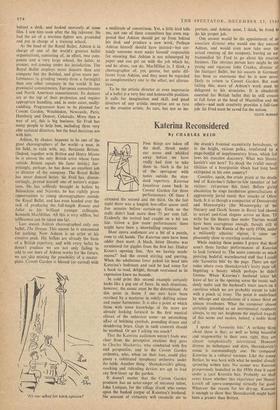behind a desk, and looked morosely at some files. I
saw him soon after the big takeover. He had the air of a wartime fighter ace, grounded and put in charge of a training school.
As the head of the Royal Ballet, Ashton is in charge of one of the world's greatest ballet organisations, consisting of, in effect, two com- panies and a very large school, the latter, at present, not coming under his jurisdiction. The Royal Ballet employs more dancers than any company but the Bolshoi, and gives more per- formances (a grinding twenty-three a fortnight) than any other company in the world. It has provincial commitments, European commitments and North American commitments. Its dancers are at the top of their profession and require appropriate handling, and, in some cases, molly- coddling. Programmes have to be planned for Covent Garden, Wimbledon, Newcastle, Paris, Hamburg and Denver, Colorado. More than a way of art, this is big business. Sir Fred has many people to help him, including three very able assistant directors, but the final decisions are with him.
Ashton, by chance, happens to be one of the great choreographers of the world—a man, in his field, to rank with, say, Benjamin Britten. (Indeed, together with Britten and Henry Moore he is almost the only British artist whose fame outside Britain equals his fame inside.) Sur- prisingly, perhaps, he has done an excellent job as director of the company. The Royal Ballet has never danced better. Sir Fred has, discon- certingly, proved himself one of nature's organ- isers. He has selflessly brought in ballets by Balanchine and Nijinska, he has rightly given opportunities to young choreographers outside the Royal Ballet, and has even handed over the task of producing the full-length Romeo and Juliet to his brilliant younger colleague, Kenneth MacMillan. All this is very selfless, but selflessness can be taken too far.
Last season Ashton choreographed only one ballet, The Dream. This season he is announced for, nothing. Now Ashton is an artist at his creative peak. His ballets are already the basis of a British repertory, and with every ballet he doesn't produce we are not only failing to add to our store of Ashton works for the future, we are also missing the possibility of a master- piece. Covent Garden is blessed (or cursed) with 'No one asked for YOUR opinion!' a multitude of committees. Yet, a little bird tells me, not one of these committees has even sug- gested that Ashton should get up from behind his desk and produce a new work. Perhaps Ashton himself should have insisted—but cer- tainly someone must make himself responsible for ensuring that Ashton is not submerged by paper and can get on with the job which he, and he alone, can do. MacMillan is, I think, a choreographer of, yes, genius, but quite dif- ferent from Ashton, and they must be regarded as complementary one to the other, not alterna- tives.
To be the artistic director or even impresario of a ballet is a very fine and honourable position. It calls for imagination and skill, and good directors of any artistic enterprise are as rare as the creative artists. As rare, but not so im- portant, and Ashton must, I think, be freed to do his proper job.
One answer would be the appointment of an associate director who would one day succeed Ashton, and would even now take over the actual running of the company, leaving an un- trammelled Sir Fred to go about his creative business. The obvious person here might be the young and vigorous John Cranko, director of the Stuttgart Ballet, but his success in Germany has been so enormous that he is now never likely to return to Covent Garden. But even failing this, more of Ashton's work must be delegated to his associates. It is absolutely essential for British ballet that he still creates at full force at the head of Macmillan and the others—and such creativity provides a full-time job. Sir Fred must be saved for the nation.
CLIVE BARNES




























 Previous page
Previous page